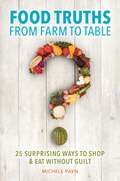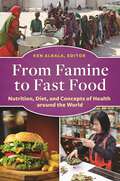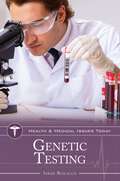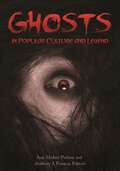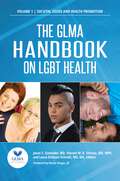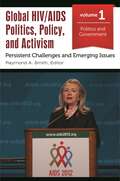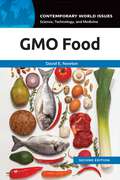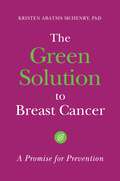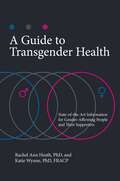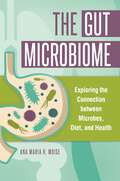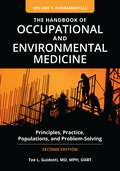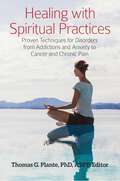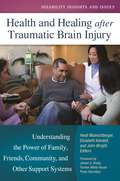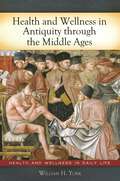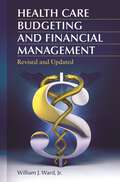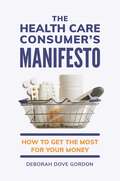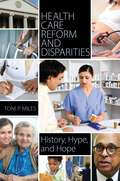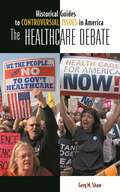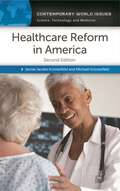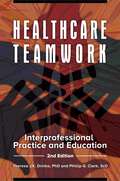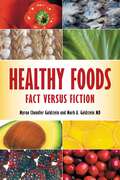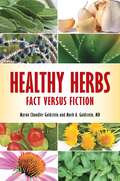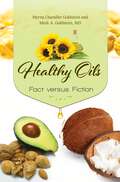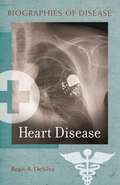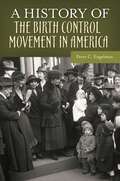- Table View
- List View
Food Truths from Farm to Table: 25 Surprising Ways to Shop & Eat without Guilt
by Michele PaynDon't believe everything you're told about food—most of it is highly misleading or completely untrue. Written by a farm and food advocate, this book identifies marketing half-truths and guides you through the aisles of the grocery store to simplify smart food shopping and restore your freedom to enjoy food.What is the only "food" on your dinner table that does not contain hormones? How can animals raised for food also be treated with respect? Is it true that a typical serving of broccoli has more estrogen than a serving of steak? Why is more than 40 percent of food wasted in the United States? Food Truths from Farm to Table: 25 Surprising Ways to Shop & Eat without Guilt answers all of these questions and many more, bringing an unheard voice into the highly emotional food debate. Authored by Michele Payn, a leading farm and food advocate with an in-depth understanding of both sides of the plate, this intriguing book helps readers understand how food is really produced, answers food critics, and points out how food marketing and labels are often half-truths or even "less-than-half truths." These 25 food truths enable an understanding of how food is grown, providing a transparent window into today's farming and ranching practices that empowers you to make informed personal choices and determine what is right for your family. Each chapter presents a farm or ranch story, answers questions around a major issue, provides science-based information, and includes a sidebar section of food truths and myths.Readers will gain insights from a food expert who offers a viewpoint that stands in stark contrast to the typical sensationalist and often negative perspective on fashionable food—accurate information that will help you to better trust the intentions and processes in farming and ranching. The revelations in this book will simplify food shopping, reduce guilt about being a consumer, and give you the freedom to enjoy your food again.
From Famine to Fast Food: Nutrition, Diet, and Concepts of Health around the World
by Ken Albala Julia Abramson M. Shahrim Al-Karim E. N. Anderson Laura P. Appell-Warren Heather Arndt-Anderson Michael Ashkenazi Babette Audant Gabriela Villagran Backman Carolyn Bánfalvi Peter Barrett Cynthia D. Bertelsen Megan K. Blake Andrea Broomfield Cynthia Clampitt Neil L. Coletta Paul Crask Christine Crawford-Oppenheimer Anita Verna Liza Debevec Jonathan Deutsch Deborah Duchon Nathalie Dupree Pamela Elder Rachel Finn Richard Foss Nancy G. Freeman Ramin Ganeshram Hanna Garth Mary Gee Che Ann Abdul Ghani Maja Godina-Golija Annie Goldberg Darra Goldstein Keiko Goto Carla Guerrón Montero Mary Gunderson Liora Gvion Cherie Y. Hamilton Jessica B. Harris Melanie Haupt Ursula Heinzelmann Jennifer Hostetter Kelila Jaffe Zilkia Janer Brelyn Johnson Kate Johnston Desiree Koh Bruce Kraig R. J. Krajewski Erin Laverty Robert A. Leonard Jane Levi Yrsa Lindqvist William G. Lockwood Yvonne R. Lockwood Janet Long-Solís Kristina Lupp Máirtín Mac Con Iomaire Glenn R. Mack Andrea Macrae Giorgos Maltezakis Bertie Mandelblatt Marty Martindale Laura Mason Anton Masterovoy Anne Engammare Mcbride Michael R. Mcdonald Naomi M. Mcpherson Katrina Meynink Barbara J. Michael Diana Mincyte Rebecca Moore Nawal Nasrallah Henry Notaker Kelly O’ Leary Fabio Parasecoli Susan Ji-Young Park Rosemary Parkinson Charles Perry Irina Petrosian Suzanne Piscopo Theresa Preston-Werner Meg Ragland Carol Selva Rajah Birgit Ricquier Amy Riolo Owen Roberts Fiona Ross Signe Rousseau Kathleen Ryan Helen Saberi Cari Sánchez Peter Scholliers Colleen Taylor Roger Serunyigo Dorette Snover Celia Sorhaindo Lyra Spang Lois Stanford Aliza Stark Maria "Ging" Gutierrez Steinberg Anita Stewart Emily Stone Asele Surina Aylin Öney Tan Nicole Tarulevicz Karen Lau Taylor Thy Tran Leena Trivedi-Grenier Karin Vaneker Penny Van Esterik Richard Wilk Chelsie Yount Marcia ZoladzThe foods eaten by a nation's population play a key role in shaping the health of that society. This book presents country-specific information on how diet, food security, and concepts of health critically impact the well-being of the world's population.A country's food culture and eating habits directly impact the health and well-being of its citizens. Economic factors contribute to problems such as obesity and malnourishment. This book examines how diet affects health in countries around the world, discussing how the availability of food and the types of foods eaten influence numerous health factors and are tied to the prevalence of "lifestyle" diseases. Readers will discover the importance of diet and food culture in determining human health as well as make connections and notice larger trends within multicultural, international contexts.An ideal aid for high school and college students in completing research and writing assignments, this book supplies detailed diet- and health-related information about most major countries and regions in a single source. Each country profile will also include a convenient fact box with statistical information such as life expectancy, average caloric intake, and other health indicators.
Genetic Testing (Health and Medical Issues Today)
by Sarah BoslaughGenetic testing has provided important clues to understanding our health, but it has also raised many ethical, legal, and medical questions and concerns. This book explores the breadth of genetic testing, its possibilities, and the controversies that surround its use.The mapping of the human genome has paved the way for a variety of genetic tests. Expectant mothers can have their fetus screened for a variety of genetic abnormalities, and couples worried that they might be carriers for a genetic disorder can be tested before deciding to have children. Women can be screened for the BRCA2 gene that has been linked to increased risk of breast cancer. Individuals curious about their ancestry can find out more about their heritage. Genetic testing can also be used to establish paternity and help solve crimes.Part of Greenwood's Health and Medical Issues Today series, this book is divided into three sections. Part I explores the history of genetic testing, including the rise of direct-to-consumer tests, and outlines the current applications and contexts in which genetic testing is performed. Part II delves deep into the ethical, legal, financial, medical, and psychological issues and controversies that surround genetic testing. Part III provides a variety of useful materials, including case studies, a timeline of critical events, and a directory of resources.
Ghosts in Popular Culture and Legend
With entries that range from specific works to authors, folklore, and popular culture (including music, film, television, urban legend, and gaming), this book provides a single-volume resource on all things ghostly in the United States and in other countries.The concept of ghosts has been an ongoing and universal element in human culture as far back as recorded history can document. In more modern popular culture and entertainment, ghosts are a popular mainstay—from A Christmas Carol and Casper the Friendly Ghost to The Amityville Horror, Ghostbusters, Poltergeist, The Sixth Sense, and Ghost Whisperer. This book comprehensively examines ghost and spirit phenomena in all its incarnations to provide readers with a holistic perspective on the subject. It presents insightful information about the contribution of a specific work or author to establish or further the evolution of ghost lore, rather than concentrating solely on the film, literature, music, or folklore itself.The book focuses on ghosts in western culture but also provides information about spirit phenomena and lore in international settings, as many of the trends in popular culture dealing with ghosts and spirits are informed by authors and filmmakers from Germany, Japan, Korea, and the United Kingdom. The writers and editors are experts and scholars in the field and enthusiastic fans of ghost lore, ghost films, ghost hunting, and urban legends, resulting in entries that are informative and engaging—and make this the most complete and current resource on ghost and spirit lore available.
The GLMA Handbook on LGBT Health [2 volumes]: [2 volumes]
by Jason S. Schneider, Vincent M. B. Silenzio and Laura Erickson-SchrothThis comprehensive review is the first handbook on LGBT physical and mental health created by the world's oldest and largest association of lesbian, gay, bisexual, and transgender health care professionals.Recent years have seen a flood of high quality research related to the health of lesbian, gay, bisexual and transgender individuals and families. The GLMA Handbook on LGBT Health is the first comprehensive resource to gather that knowledge in one place in the service of vital information needs. Both accurate and easy to understand, the two-volume handbook addresses physical, mental, and emotional health, as well as policy decisions affecting the LGBT community from youth through old age. Volume One is devoted to overall health of the population and preventive care, while Volume Two examines disease management. Entries discuss concerns as diverse as HIV/AIDS, substance abuse, domestic violence, depression, heart health, policy and advocacy, and research. The clear but detailed articles in this groundbreaking work will help readers cut through the noise and controversy surrounding scientific advances to make informed choices about their health and well-being.
Global HIV/AIDS Politics, Policy, and Activism [3 volumes]: Persistent Challenges and Emerging Issues [3 volumes]
by Raymond A. SmithAn international team of specialists in politics, policy, and activism provide an indispensable guide to the persistent challenges and emerging issues posed by the global HIV/AIDS epidemic, now in its fourth decade.The HIV/AIDS epidemic is at a critical turning point. Compelling new findings herald the potential to eventually grind the epidemic to a halt through a combination of expanded treatment coverage and new biomedical approaches to prevention. At the same time, the severe global economic downturns have negatively affected wealthy donor nations that have provided the funds and technical support for programs in the developing world. It is against this backdrop that this landmark three-volume set was developed. It provides a broad overview of the critical political issues surrounding HIV/AIDS, inspects key areas of policy and policymaking, and spotlights the most important forms of activism and community mobilization.The volumes reflect an eclectic and wide-ranging set of issues written by an international team comprising dozens of authors from nations including the United States, the United Kingdom, Ghana, South Africa, Brazil, Cambodia, Norway, and Qatar. The international contributors represent a variety of disciplines and bring with them a range of styles and methodological approaches appropriate to their specific topics and disciplines. An important addition to academic and public libraries, this expansive work will benefit students and other readers interested in politics, policymaking, public health, activism, and community mobilization, both in the United States and globally.
GMO Food: A Reference Handbook (Contemporary World Issues)
by David E. NewtonGMO Food: A Reference Handbook offers an in-depth discussion of genetically modified food. It covers the history of, opposition to, regulation of, and labeling of genetic modifications, along with the potential benefits and harm involved.GMO Food: A Reference Handbook is intended to serve as a research guide for young adults in high school and beyond. Students at all grade levels should be able to use the book as an introduction to the history of genetic engineering of organisms and the use of this technology for the development of new forms of crops and foods.They will learn briefly about historic methods of plant and animal modification (such as cross-breeding) and, in more detail, how discoveries since the late nineteenth century have greatly changed the process of plant and animal modification. These discoveries include important steps forward in genetics, biochemistry, molecular biology, genetic engineering, and related fields. They will also learn about the variety of social, political, philosophical, economic, and other issues that have arisen alongside these scientific advances, as well as about some of the laws, regulations, and other solutions that have been developed for dealing with the range of attitudes about genetically modified foods. The second edition covers developments since 2014.
The Green Solution to Breast Cancer: A Promise for Prevention
by Kristen Abatsis Ph.D.This unique, research-based investigation of the U.S. breast cancer movement compares the "pink" and "green" efforts within the movement and documents their use of similar citizen-science alliances, despite the contention over the use of consumer-based activism and pink products.Breast cancer activism is one of the most flourishing research and health advocacy movements in U.S. history. Yet the incidence of breast cancer is continuing to increase. This critical and revealing text investigates breast cancer activism in its two forms—the "pink movement" that focuses on developing awareness of, coping with, and managing breast cancer; and the "green movement" that strives to determine the possible environmental causes of breast cancer—such as pesticides, chemicals, and water and air pollution—and thereby hopes to prevent breast cancer.What caused this new green movement to develop? Will it replace or merge with the pink movement? Does either approach offer more promise for a solution? And how do the two movements differ in their positions or methodology towards a similar goal? With information culled from interviews with more than 50 industry stakeholders, The Green Solution to Breast Cancer: A Promise for Prevention argues that key attributes such as strategy, mission, and branding have led to a greater convergence between the pink and green wings of the movement and presents information that enables readers to consider if either approach might be the shorter route to beating breast cancer.
A Guide to Transgender Health: State-of-the-Art Information for Gender-Affirming People and Their Supporters (Sex, Love, and Psychology)
by Rachel Ann Ph.D. Katie Wynne Ph.D.Provides the most up-to-date information on transgender science and its applications, for gender-diverse people, their supporters, and the professionals who assist them to lead healthy, happy, and successful lives.The number of people presenting at gender clinics worldwide for assistance has increased exponentially in the last decade. Transgender people also have become much more prominent in the media. An increase in political populism, however, has brought unprecedented attacks on trans* people. Covering a wealth of topics relevant to transgender people and their supporters, both social and professional, Heath and Wynne help readers to see through the flawed arguments of those who wish to inflict damage on the trans* community. The content of this book ranges from theoretical ideas about the origin of gender diversity to practical solutions for trans* people to enjoy life in their chosen gender. Physical health topics include hormone therapy, puberty blockers, breast augmentation/reduction, gender confirmation surgery, and speech therapy. Mental health topics include dealing with discrimination, bullying, and transphobia. The text is presented so that it can be understood with no scientific background, but is also highly relevant to the health professional. Copious footnotes and references allow those wishing to delve more deeply into the topics to do so easily. The book is also supported by readily accessible resources available online and on social media.
The Gut Microbiome: Exploring the Connection between Microbes, Diet, and Health
by Ana Maria MoiseThis accessibly written, comprehensive summary of research findings on the gut microbiome and its implications for health and disease—a topic of growing interest and concern—serves as an essential resource for teachers and students.Most people know that the digestive tract contains billions of helpful gut bacteria, but how does the gut microbiome affect our health? What exactly do these bacteria do, and what are the negative effects when these microorganisms are harmed by what we eat and do? What impacts might they have on conditions such as irritable bowel syndrome (IBS), obesity, and autism? This book provides an accessible, holistic introduction to the study of the human gut microbiome and its effects on digestion and disease—one of the newest and most rapidly expanding fields in medicine today.The gut microbiome is known as "the forgotten organ" because it is not identified as part of the human body per se, yet it has an immense influence on many systems in the body. The Gut Microbiome: Exploring the Connection between Microbes, Diet, and Health explains what the microbiome is, the many functions it serves, how it can be either harmed or supported by our actions, and the role it may play in various diseases and in determining our overall health. The book examines the various potential causes of imbalance in the microbiome, such as diet and other lifestyle factors, and then identifies strategies for improving human health by protecting the gut microbiota. The science-based information is detailed but accessible to general readers or students without extensive background knowledge.
The Handbook of Occupational and Environmental Medicine [2 volumes]: Principles, Practice, Populations, and Problem-Solving [2 volumes]
by Tee L. GuidottiProvides health professionals with a single, accessible, and interesting source to prepare for the field of occupational and environmental medicine. The new edition is extensively updated and includes questions for review in preparation for taking exams.This set is designed to be a thorough introduction for physicians entering the occupational and environmental medicine field, whether preparing for specialty examinations or moving into the field from other medical specialties or from primary care. It also serves as a convenient guide and reference for nurses, health professionals, and those outside of health care who need a quick orientation. The set is written with a strong and coherent point of view about the value of occupational and environmental medicine and commitment to ethical, worker-centered practice. It is unusual in the depth of its coverage; its inclusion of important topics that are usually overlooked in textbooks of the field, such as risk science; its emphasis on good management of occupational health services; and its thorough integration of material that fits topics together rather than presenting them as if they were separate and unrelated.
Healing with Spiritual Practices: Proven Techniques for Disorders from Addictions and Anxiety to Cancer and Chronic Pain
by Thomas G. PlanteThis interdisciplinary study details spiritual approaches including meditation and yoga shown to be helpful in improving physical and psychological well-being.Whether a person suffers from a psychological or physical malady, such as depression, addictions, chronic pain, cancer, or complications from pregnancy, the best practice treatments likely include one common thread: spiritual practice. From meditation and yoga to spiritual surrender and religious rituals, spiritual practices are increasingly being recognized as physically and mentally beneficial for recovering from illness and for retaining optimal health. Healing with Spiritual Practices: Proven Techniques for Disorders from Addictions and Anxiety to Cancer and Chronic Pain, edited by the director of one of the nation's best-known university institutes of spirituality and health, explains current and emerging practices, their benefits, and the growing body of research that proves them effective. Comprising chapters from expert contributors, this book will appeal to students, scholars, and other readers interested in psychology, medicine, nursing, social work, pastoral care, and related disciplines.
Health and Healing after Traumatic Brain Injury: Understanding the Power of Family, Friends, Community, and Other Support Systems (Disability Insights and Issues)
by Heidi Muenchberger, Elizabeth Kendall and John WrightIn this groundbreaking book, experts show what a difference support systems—family, friends, community and social programs—can make towards the recovery of the millions of people who suffer a traumatic brain injury each year.Health and Healing after Traumatic Brain Injury: Understanding the Power of Family, Friends, Community, and Other Support Systems stresses the importance of an integrated and systems approach to healing. This book offers a unique combination of practitioner perspectives on what works for individual patients, consumer stories and learned insights over time, as well as researcher insights from innovative programs. It provides a holistic account of the important factors in living with a brain injury that will inform and benefit health practitioners and policy makers as well as people with brain injuries and their family members and friends.The chapters explore the current best evidence and contemporary views on healing that draw on optimism, aspirational living, and meaningful partnerships. The authors focus on the emergent area of the salutogenic experience of injury—how brain injury changes and shapes lives in positive ways—and on the variables within individuals and their environments that provide a supportive influence in long-term healing.
Health and Wellness in Antiquity through the Middle Ages (Health and Wellness in Daily Life)
by William H. YorkEarly medical practices are not just a historical curiosity, but real stories about people and health that may teach us much about the 21st century. This intriguing volume offers a comparative examination of early medicine and health care in regions as varied as ancient Mesopotamia, Egypt, Greece, Rome, India, China, the Islamic world, and medieval Europe.Health and Wellness in Antiquity through the Middle Ages compares and contrasts health-care practices in seven different cultures from around the world. In considering the range of medical practitioners in each society, and the kinds of health care they provided, it examines the development of a written medical tradition, the methods of medical education, the practice of surgery, and the theories and practices of pharmacy. Other topics include the application of medicine in specific contexts, such as the treatment of women, children, and those with mental illness. Another important theme explored is the impact of religion and state institutions on the development, implementation, and results of medical care as experienced by real people in real life. Throughout, the book offers an international historical perspective, which allows for greater comparative and critical understanding of how different cultural beliefs influenced the development and management of health care.
Health Care Budgeting and Financial Management
by William J. Jr.In today's chaotic health reform environment, it is especially important for non-financial health care managers to have a practical guide to the tools and concepts they need to manage their human, supply, and equipment resources.Today's health care managers, frequently, were yesterday's technicians, physicians, and nurses. This puts them in an interesting predicament, since they know the health care side of the business but often lack the financial management skills necessary to create budgets and manage finances in a health care setting. In this guide, William J. Ward Jr. offers easy-to-understand explanations of basic accounting concepts, including cash flow, operating cost and cost behavior, revenue and reimbursement, and so much more.Providing clearly presented financial information in the context of health care, Ward's book is a one-stop desk reference that provides practical, useful tools and knowledge that readers can immediately put to use. It will help managers, directors, and clinical leaders who work in hospitals, physician practices, and other provider organizations to effectively manage their financial resources on a day-to-day basis, providing guidance for essential tasks such as preparing budgets, managing their departments, and making decisions around financial issues.
The Health Care Consumer's Manifesto: How to Get the Most for Your Money
by Deborah Dove GordonA health care executive at Harvard explains how to become a savvy consumer and get the value we all deserve for our health care spending.This book navigates and demystifies the confusing world of health care shopping. Readers go on a guided tour inside American health care to learn why it is so messy, and who is invested in keeping it that way. The text offers a new vision of how health care could work if it were truly designed to meet consumer needs, creating a call to action on how to demand and help create such a system. A wake-up call to an industry tenuously holding on to the status quo and ripe for true disruption, this book outlines what consumers can do themselves and demand from doctors, hospitals, health plans, and policy makers to get more for their health care spending and, in so doing, reshape the health care system into one we all deserve. Using real and compelling consumer stories intertwined with expert analysis, this book illustrates why it is so difficult to act as an engaged health care consumer in the United States and pulls back the curtain to expose the forces that hold the system in place.
Health Care Reform and Disparities: History, Hype, and Hope
by Toni P. MilesThis book exposes and examines how Medicare, Medicaid, and private health insurance plans combined with widespread business practices and fraud create inequity—the root cause of our dysfunctional health care system, and the reason for the rising cost of health care for all Americans.In Health Care Reform and Disparities: History, Hype, and Hope, prolific author Toni P. Miles, MD, PhD, uniquely expands the usual discussion of health disparities by including and emphasizing the voice and perspective of the consumer, and by featuring policy, media, and financing data. Highlighting the subjective experience humanizes the effects of bureaucratic inequity and inefficiency, while examining the facts and figures spotlights real-world opportunities for moving away from operating on a discrimination basis and refocusing on quality of care. The first chapter outlines the larger historical context of the health care crisis before subsequent sections describe individual aspects of the health care system—and each one's role in creating or exacerbating disparities. Health care issues specific to demographic groups such as young adults are addressed. This work is an accessible, eye-opening resource for educators, students, and policy makers, as well as anyone wanting to find up-to-date details on the policies and regulations evolving from the Affordable Care Act.
The Healthcare Debate (Historical Guides to Controversial Issues in America)
by Greg M. ShawWith the debate over health care consuming the nation, this timely book looks at the evolution of healthcare policy in the United States throughout its history.Concise, authoritative, and unbiased, The Healthcare Debate provides meaningful context for thinking about one of the most controversial public policy issues the United States faces. It traces the evolution of the argument over the government's role in healthcare financing and delivery since the early 1800s, with an emphasis on the major reform efforts since the mid-20th century.Following the complex dynamics of public health policy across U.S. history, The Healthcare Debate brings together a wide range of voices on the subject—presidents, policymakers, reformers, lobbyists, and everyday citizens. Each of its eight chronologically organized chapters focuses on the battle over government involvement in healthcare in a specific era, drawing on historic documents and the latest retrospective research. With President Obama making healthcare reform his top domestic priority in his first year in office, this remarkable new book could not be more timely.
Healthcare Reform in America: A Reference Handbook (Contemporary World Issues)
by Jennie Jacobs Kronenfeld Michael KronenfeldThis valuable handbook makes the U.S. health care system understandable, reviews the Affordable Care Act (ACA) or "Obamacare," describes past health care reform efforts, and covers the important organizations and people involved in U.S. health care reform.Why does the United States produce poorer outcomes for Americans in terms of health care than most other developed countries that spend a lower percentage of their Gross Domestic Product (GDP) on health care? Should health insurance be private or should it be managed by the government? The second edition of Healthcare Reform in America: A Reference Handbook addresses these complex and difficult questions and many more in its thorough treatment of one of the most controversial issues in contemporary American discourse. The work provides a broad introduction to the history and key issues in the development and reform of the U.S. health care system. It then addresses the recent passage of the Affordable Care Act and the myriad of significant expected changes due to the Act, thereby providing readers with information essential to understanding the current issues regarding health care reform. This work serves as a valuable resource to high school and college students as well as to general readers wanting to learn about the history and current focus of health care reform in the United States.
Healthcare Teamwork: Interprofessional Practice and Education
by Theresa J.K. Drinka Phillip G. ClarkBoth comprehensive and accessible, this is an ideal resource for anyone who plans to teach or practice integrated, cost-effective healthcare in the 21st century.Currently, there is no coordinated system for training health-profession students to address the needs of patients with complex illnesses, nor is there a coordinated system for effectively delivering care to these patients. This book explores both sides of the problem, bringing interprofessional practice and education together to show how they are complementary—and how they can be integrated to provide better care.In many respects, this book is a personal account of the authors' experience with interprofessional teamwork and education over the past 40 years. It discusses what works and what doesn't and includes interviews, examples, and case studies that illustrate the perspectives of healthcare professionals, patients, and caregivers. This second edition illuminates ways in which today's business model has changed interprofessional healthcare team practice and education, and it examines the needs of patients relative to healthcare teams and practitioner education. An entire chapter is devoted to the patient's position as both teacher and learner in relation to the team. The theoretical foundations of practice and education are highlighted, but the book also shares models that can be used for the practical development of programs.
Healthy Foods: Fact versus Fiction
by Myrna Chandler Goldstein Mark A. MDThis book presents research findings about 50 foods that are commonly touted as healthy and educates readers about the medical problems they purportedly alleviate or help prevent.It is always in the best interest of those who market foods to make grandiose claims regarding their nutritional value, regardless of whether actual scientific proof exists to support such a claim. Even diligent and educated consumers often have difficulty discerning facts from mere theory or pure marketing hype.As the incidence of childhood obesity in the United States continues to increase at an alarming rate and food costs skyrocket, this book arrives at a perfect time for health-conscious consumers, providing an authoritative reference for anyone looking to make wise eating decisions at home, work, school, or in restaurants. Healthy Foods: Fact versus Fiction is the result of a collaborative effort between a medical doctor and an award-winning journalist and author on nutrition. This book provides actual research findings to shed light on the true benefits of the most popular health foods—and in some cases, debunk misconceptions surrounding certain foods.
Healthy Herbs: Fact versus Fiction
by Myrna Chandler Goldstein Mark A. MDConsolidating unbiased, peer-reviewed information from many sources, this book provides a one-stop resource on the use and health benefits of 50 different herbs.While the use of herbs and herbal supplements seem an attractive alternate to man-made therapies, such use is often inspired by anecdotal evidence rather than sound clinical research. Healthy Herbs: Fact versus Fiction examines the health claims associated with 50 popular herbs and coalesces the clinical findings on these natural substances. This useful resource examines the history and use of herbs and will ultimately help readers make informed decisions regarding these natural therapies.The findings in the book are culled from credible sources such as international, peer-reviewed journals, providing nomenclature, history, common usage, effectiveness, and additional suggested reading on selected herbs and herbal supplements. Rather than advocating for or against alternative medicine or herb use, the book provides authoritative, unbiased, and evidence-based information so the health conscious can make informed decisions for themselves.
Healthy Oils: Fact versus Fiction
by Myrna Chandler Goldstein Mark A. MDUsed in moderation, many oils can be beneficial to one's diet and lifestyle. This book presents accurate information on more than two dozen oils, examining the health claims associated with popular oils along with the clinical research findings.In the past, consumers were warned to avoid eating foods made with coconut oil, but more recently opinions about this oil have shifted. Many people now consider olive oil to be the most healthful—but is there truth behind this idea? Today's consumers are constantly bombarded with claims regarding consumption of oils, yet references to the scientific studies assumedly behind these statements are rare. This book dispels the common myths about oils, examines the health claims associated with popular oils and fats, and presents useful information backed by scientific findings. The book's 47 entries cover common oils such as canola and olive oil to less commonly used oils, such as argan, avocado, and krill oil. The research results are gathered from international, peer-reviewed journals, providing readers with information from credible sources. An ideal resource for nutritionists, nutrition students, and anyone seeking scientifically backed information about the health benefits of oils, Healthy Oils: Fact versus Fiction serves as an indispensible tool for making informed health decisions.
Heart Disease (Biographies of Disease)
by Regis A. SilvaDisease conditions that affect the human heart and the methods used to diagnose and treat them are all covered in one concise volume.Written by a past president of the Boston Chapter of the American Heart Association, Heart Disease is a comprehensive account of the leading cause of death in the West. Sequential chapters describe the structure and function of the heart, the various disease states, and the treatments for each major disease. In addition, the book examines the vast array of diagnostic tests and the most advanced treatments available, from basic drugs for prevention such as aspirin to transplants and artificial hearts.Dr. de Silva, who teaches at Harvard Medical School, also covers historical aspects of heart disease, discoveries about the structure and function of the heart, and the ways in which heart disease can be diagnosed and treated. Underlying conditions that affect the heart are described and linked to the treatments and devices used to correct disease conditions.
A History of the Birth Control Movement in America (Healing Society: Disease, Medicine, and History)
by Peter C. EngelmanThis narrative history of one of the most far-reaching social movements in the 20th century shows how it defied the law and made the use of contraception an acceptable social practice—and a necessary component of modern healthcare.A History of the Birth Control Movement in America tells the extraordinary story of a group of reformers dedicated to making contraception legal, accessible, and acceptable. The engrossing tale details how Margaret Sanger's campaign beginning in 1914 to challenge anti-obscenity laws criminalizing the distribution of contraceptive information grew into one of the most far-reaching social reform movements in American history. The book opens with a discussion of the history of birth control methods and the criminalization of contraception and abortion in the 19th century. Its core, however, is an exciting narrative of the campaign in the 20th century, vividly recalling the arrests and indictments, banned publications, imprisonments, confiscations, clinic raids, mass meetings, and courtroom dramas that publicized the cause across the nation. Attention is paid to the movement's thorny alliances with medicine and eugenics and especially to its success in precipitating a profound shift in sexual attitudes that turned the use of contraception into an acceptable social and medical practice. Finally, the birth control movement is linked to court-won privacy protections and the present-day movement for reproductive rights.
